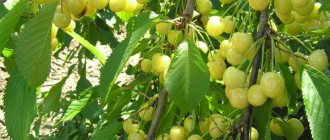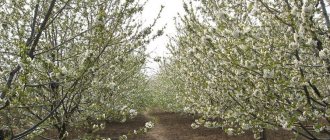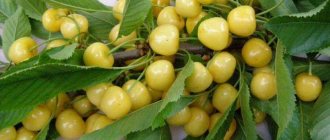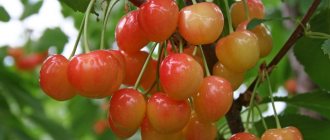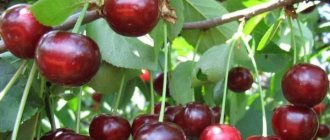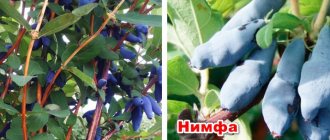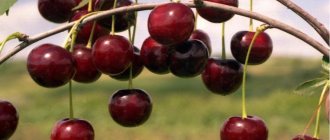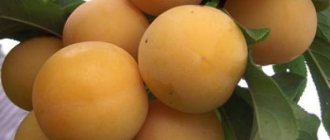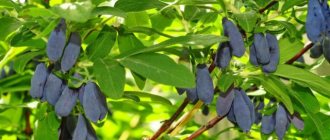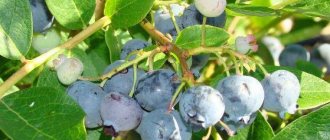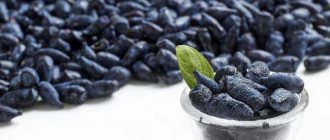History of the variety's creation
The Bryanochka cherry was bred at the famous Lupin Research Institute (Bryansk region), which mainly specializes in breeding varieties of cherries and sweet cherries. The breeders who bred the Bryanochka cherry are M.V. Kanshina, L.I. Zueva, A.A. Astakhov. The Red Dense cherry was taken as the basis for the new variety. Work on developing a new variety has been carried out since the end of the last century. Then, after tests, this cherry variety was included in the Russian State Register in 2006.
The Bryanochka cherry is recommended for cultivation throughout almost the entire territory of Russia (except for the northern regions).
Preparing for landing
Growing cherries is a long-term project. Therefore, you need to carefully prepare for its planting: choose a suitable place and the best planting material, and also determine the correct planting time.
Selecting the best seedlings for planting
When choosing a seedling, you need to pay attention not only to its beautiful appearance. Only a high-quality tree will produce a good harvest of tasty berries in the future.
Criterias of choice:
- the grafting site is clearly visible on the trunk (variety characteristic);
- many branches;
- there is only one conductor, not branched, strong, without damage;
- if there are leaves, they must be healthy, without signs of disease, then they must be removed;
- the root system is undamaged, strong, not dry, but moist.
In order for the tree to withstand transportation well, it is recommended to wrap the root with a damp cloth and a plastic bag on top.
Choosing a suitable location on the site
Cherry is a sun-loving and drought-resistant plant. Therefore, the landing site must be carefully selected. The site is suitable if:
- it is sunny and sheltered from cold winds;
- flat place, hill, gentle slope, where rainwater does not stagnate and there is no groundwater;
- the soil is not peaty, clayey or sandy, but fertile loamy and sandy loam.
The land needs to be prepared 15–20 days before planting. For spring planting work, it is advisable to carry out preparations in the fall. Preparation includes deep digging with the simultaneous application of organic matter (humus or compost) and phosphorus-potassium fertilizers (superphosphate and potassium salt). You can use a special fertilizer for cherries.
Acidic soil needs to be limed, because... Cherries may not take root at all.
High acidity can be identified by abundantly growing sorrel and plantain. Lime is not applied together with fertilizers, but later. You should not add it during planting, so as not to burn the roots of the plant. It is best to carry out liming a week before planting.
Landing dates
In different regions, cherries are planted at different times. The timing depends on the climate and weather conditions. In southern regions with mild winters, it is better to plant seedlings in the fall a month before the ground freezes. The plants will have time to take root and will calmly withstand the winter temperature drop. And in the central and northern regions, it is advisable to plant in early spring, when the earth has already warmed up. It is important to have time to plant the seedling before the buds swell on it. During the spring-summer period, the tree will get stronger and gain strength for the upcoming harsh winter.
Cherry variety Bryanochka: main characteristics and description
The Bryanochka cherry is of medium height, its central trunk rarely grows above 3 m, the tree grows intensively. The number of side branches is average; as a result, the crown is not very thick, its shape is pyramidal. The shoots are straight, the bark of the trunk and branches is smooth, its color is brown.
The foliage is elliptical in shape with a small pointed tip, and the color is bright emerald. The flowers are small in size, collected in bunches of 3, the petals are round, white, and do not touch each other.
Photo of Bryanochka cherry
On a note!
The Bryanochka variety is late in terms of fruit ripening - flowers appear in the last days of May, and the berries begin to ripen in the last ten days of July.
The berries are heart-shaped, slightly compacted on top. The size of ripe fruits is large, weighing about 6 g. The skin is dense, of medium thickness, cannot be felt in food, does not crack even in unfavorable weather conditions, smooth, dark ruby, with a characteristic shine. The pulp is compact, juicy, very sweet, dark red in color.
THE BEST CHERRY VARIETIES!
Cherry variety Odrinka Chereshnya Fatezh Cherry Ovstuzhenka
The taste rating of the Bryanochka cherry by tasters is very high - 5 points out of 5 possible.
Thanks to the dense skin of the berries, the harvested crop can be transported to any distance, while the fruits do not crack, do not lose their good presentation and excellent taste. The harvest is stored for about a week.
Cherry Bryanochka brief review - video
It is preferable to use the collected berries for food due to their excellent taste. But the harvested crop is used to make jams, marmalade, marmalade, and freezing. Also, delicious liqueurs and homemade liqueurs are obtained from the collected cherry fruits.
This cherry variety is very sensitive to the level of moisture in the soil; with a lack of moisture, the fruits become drier. Therefore, it is necessary to regularly water the trunk circles of the Bryanochka cherry; during dry periods this should be done once every 25-30 days.
Cherries of this variety are highly resistant to frost,
flower buds also practically do not suffer from winter frosts and spring return frosts, so
the fruiting of this stone fruit tree is stable and almost always abundant.
Characteristics of culture
The Bryanochka variety of cherries was bred specifically for cultivation in different climatic zones. Therefore, the plant has certain properties and characteristics necessary for proper growth and care.
Resistance to low temperatures and drought
The tree can withstand severe frosts and sudden temperature changes. Even after cold winters, Bryanochka quickly comes to her senses and begins to actively grow and develop. A flowering plant can also withstand light frosts. Sweet cherries do not like excess moisture. But during drought it requires additional watering.
Susceptibility to disease and parasite infestation
Trees of the Bryanochka variety have natural immunity against klyasterosporiosis, moniliosis and coccomycosis. But to prevent the plant from being exposed to other fungal diseases, proper and timely care is enough.
The main enemies of cherries are aphids and cherry flies. Pests not only destroy the crop, but can completely destroy the plant.
Productivity of the Bryanochka variety
This variety is not too fast-bearing - the first harvest is harvested from this cherry 5 seasons after planting the seedling in a permanent place. On average, the yield in the first years is low - up to 20 kg per tree, but every year it increases. But after 20-25 years, these cherries begin to age, and their yield decreases. Therefore, it is necessary to plant young trees of this variety to renew it.
But it should be noted that Bryanochka cherries show good yields throughout almost the entire territory of Russia.
Photo of Bryanochka cherry harvest
Step-by-step planting instructions for beginners
It is recommended to prepare the pit in advance, 2 weeks before planting. You need to dig a hole with a diameter of 80 cm and a depth of 60 cm. The dug soil must be mixed with fertilizers (compost, ash, superphosphate and potassium sulfur). This is especially important if the soil has not been fertilized since the fall. The prepared earth mixture must be returned to the pit again.
Before planting, you need to inspect the roots of the seedling and trim off dry, weak and damaged shoots. Then they need to be soaked in water for a couple of hours, dry roots - for 10-12 hours. If the ground has been limed, the root system must be immersed in clay or earthen slurry to protect it from burns.
Next you need to proceed in the following order:
- Dig the soil out of the prepared hole again.
- Drive a peg, the height of which above the ground will be 50 cm, to tie the tree trunk to it.
- Place a mound of fertilized soil at the bottom of the hole.
- Lower the seedling inside, straightening the roots from above on the mound. The root collar should rise 5 cm above the ground surface.
- Cover with the rest of the soil, compacting it well so that there are no air pockets left.
- Draw a ditch around the trunk with a radius of 30 cm for future watering.
- Pour a bucket of water and cover the ground with peat mulch.
Advantages of the variety
Experts include the main advantages of the Bryanochka cherry variety:
- high productivity;
- stable and annual fruiting;
- flowering occurs at the end of May, when the return spring frosts have already passed, so the flowers are not damaged by cold;
- high frost resistance of wood and flower buds;
- excellent taste qualities of ripe Bryanochka fruits.
EXCELLENT VARIETY OF CHERRY!
Leningradskaya black cherry
According to gardeners, this cherry has only one drawback:
the tree is self-sterile, so for good yield it is necessary to plant pollinator trees nearby with the same flowering periods.
Planting Bryanochka cherries
The process of planting and further caring for Bryanochka cherries is not much different from growing other varieties of this fruit tree.
This late-ripening variety can be planted in both autumn and spring.
But in the fall, it is better to plant seedlings of the Bryanochka variety only in the southern regions of Russia, and at least 20 days should remain before the onset of cold weather.
Photo of cherry seedling
On a note!
And in colder regions, it is recommended to plant Bryanochka cherries in a permanent place only in the spring - in mid-April, when the snow has melted, the soil has warmed up to 13-15 degrees Celsius, and the buds on the trees have not yet swelled.
The site for planting this cherry can be on a gentle slope or a flat surface that is well lit by the sun. There should be no tall buildings or trees nearby that could shade this cherry tree. The soil may not be too fertile, but it is recommended that it not be too wet or waterlogged. Groundwater should not come closer to the soil surface than 1.6-2.0 m. Closer water occurrence can have a negative impact on the root system of cherries.
This stone fruit tree should also be protected from strong winds and drafts.
Photo of planting cherries
It is not recommended to plant some fruit trees and shrubs next to cherries:
apple trees, pears, blackberries, raspberries or gooseberries.
And vegetable plants from the nightshade family, planted next to cherries, will attract some pests. It is strictly forbidden to plant trees such as linden, birch, spruce, and pine next to this variety of cherries.
Important!
And birch is completely unsuitable for growing in a garden plot, as it draws too much water from the soil.
INTERESTING!
The best varieties of cherries for Siberia
The best neighbors for cherries are cherries, plums or honeysuckle.
For planting, you need to purchase two-year-old Bryanochka trees, the root system of which is about 25 cm in length, and the height of the central trunk is about 100 cm.
Before purchasing, carefully inspect the root system and shoots - they should look healthy, have no external damage or signs of disease.
Photo of cherry planting scheme
Before planting, the roots of the plant are placed in a container with water for several hours, and then for 30-40 minutes in Kornevin’s solution to disinfect the roots.
Planting holes should be about 0.7 m in diameter and up to 0.5 m deep. A layer of fertile soil is poured onto the bottom of the hole, forming a mound from it. A seedling is placed on it, a stake is dug in next to it as a support, to which the tree will be tied after planting.
Care
In the spring, it is necessary to remove all damaged and frostbitten branches, and treat the cuts with garden varnish. When the air warms up to +18 degrees, spraying against pests and diseases is carried out. Those fertilizers that were applied during planting “work” for three years, after which time Bryanochka will need minerals.
In summer, around the tree it is necessary to loosen the soil ten centimeters deep. In the absence of sufficient rainfall, Bryanochka needs to be watered up to five times per season. If signs of disease appear, do not delay processing so that the crop does not suffer. In summer, do not forget about the necessary thinning, remove new shoots and broken branches.
In the fall, apply products under the roots that fight pests that decide to overwinter in the roots of the tree. Whiten the trunks and bases of skeletal branches at the end of October.
Further care for Bryanochka cherries
The main thing when caring for these cherries is to adhere to the watering regime. The future productivity of the tree and the taste of the fruit directly depend on the correct implementation of this agrotechnical procedure.
During the summer, cherries should be watered during the following periods:
- before the buds begin to swell;
- during the flowering period;
- when the ovaries begin to actively form;
- In the fall, in the process of preparing trees for winter, moisture-charging irrigation is carried out.
If the summer is dry, then you need to water the Bryanochka cherry about once a month; in rainy seasons, the amount of watering should be reduced.
After watering or rain, the tree trunk circles are loosened, and then a layer of mulch is added.
Feeding bushes
In the first two seasons, Bryanochka cherries should not be fertilized, because the tree only needs the fertilizers applied during planting.
From the third season, fertilizing is applied according to the following scheme:
- in the spring, during the growth of green mass and flowering, fertilizers containing nitrogen, for example, urea or ammonium nitrate, are added to the soil. This element activates the growth of vegetative mass and root system;
- during the period of the appearance of ovaries and active ripening of fruits, fertilizing containing phosphorus and potassium, as well as organic matter, is applied to the tree trunk circles;
- Before the start of the winter season, a complete complex fertilizer is applied to the soil.
Photo of fertilizing cherries
Pruning Bryanochka cherries
In the first four seasons, formative pruning of young seedlings is carried out.
During planting, the central trunk is cut to a height of 0.6 m; in the process of further pruning, the tree is formed into 4 tiers, each of which should have 4 skeletal branches. Each gardener shapes the height of the tree according to his wishes.
In the spring, before the buds swell, sanitary pruning of the Bryanochka cherry should be carried out. In this case, all frozen, damaged and dry branches are removed.
Photo of cherry pruning scheme
Preparing cherry trees for winter
In the process of preparing this cherry variety for winter, a number of standard agrotechnical procedures are carried out:
- after the end of the leaf fall process, the tree trunk circles are cleared of plant debris and fallen leaves;
- moisture-charging irrigation is carried out;
- complex mineral fertilizer is applied;
- the soil is dug up, and a layer of mulch 10-12 cm thick is laid on top. Peat or rotted sawdust can be used as mulch;
- Young trees need to be covered for the first few seasons. They wrap their trunks with spruce branches or any non-woven fabric. An adult cherry tree does not need such measures - this tree calmly tolerates frosts of 28-30 degrees Celsius.
Diseases and pests
Like any fruit tree, the Bryanochka cherry variety is affected by diseases and pests. To prevent the death of the plant, it is necessary to take measures to combat them.
Hole spot
With this disease, brown spots appear on the leaves, after which holes appear in their places. Cracks may appear on the branches and gum may leak out of them.
To cure the disease, all affected shoots should be immediately removed and burned. The soil around the trunk should be dug up. After this, the tree must be sprayed with copper sulfate.
Gray rot
The disease is also called moniliosis. In humid weather, brown spots appear on the leaves, which eventually become covered with plaque.
Shoots should be cut at a level that is 10 centimeters below the affected area. To improve the health of the tree, one of the fungicides such as Horus, Topsin or Azocene is used.
Coccomycosis
Brown spots appear on the front side of the leaves. Over time, they form one large spot, and the leaf itself begins to dry out. Already in summer the tree can become bare.
All fallen leaves should be removed from the area and burned. After 10 days, the cherries should be sprayed with fungicides, Bordeaux mixture or vitriol.
cherry fly
A small fly with striped wings lays its larvae in green berries. After eating the pulp, they turn into a fly.
To combat the pest, products such as Fitoverm and Zdorovy Garden are suitable. The spraying procedure should be done during the flowering period even before the petals begin to fall.
Cherry sawfly
The beetle lays eggs on the leaves and seals them. The larvae completely eat the leaves, descend to the ground and burrow into it.
For prevention, you should dig up the soil around the trunk in spring and autumn. The use of drugs such as Karate, Karbofos and Aktara is also effective.
Weevil
A red-green beetle with a proboscis. Destroys ovaries and berries by making holes in them. It prefers to overwinter in the ground under the plant.
You should dig up the soil every year in the fall, you can make hunting belts, and use insecticides.
Black aphid
There are a large number of ants on the tree, the leaves are curled, and small black bugs can be found around.
You can fight the pest with the help of drugs such as Fitoverm, Iskra, Intavir.
Scab
On the foliage and berries you can observe olive-brown velvety spots, abundantly covered with fungal spores.
For prevention, all fallen leaves and berries should be promptly removed and disposed of, and the soil in tree trunk circles should be dug up and loosened.
Reviews from those who planted Bryanochka cherries
Natalya, 45 years old, Bryansk region: The Bryanochka cherry variety is the best choice for our region, as it tolerates cold winters well, and neither shoots nor flower buds are damaged. Flowering occurs at the end of May, so the buds are not damaged by spring frosts. As a result, the fruiting of the tree is stable. But next to this variety, another variety of cherry with the same flowering period must be planted simultaneously for mutual pollination. Otherwise, Bryanochka's harvest will be very low.
Nikolay, 50 years old, Pskov region: In my garden plot I planted several varieties of cherries - Iput, Vengerka, Bryanochka. These trees simultaneously entered the fruiting season and actively cross-pollinate each other, resulting in very high yields. My children and grandchildren especially like the Bryanochka fruits - large, very sweet. And I make homemade liqueur from the fruits of these cherries - it turns out sweet and rich.
This cherry variety is a good choice for gardeners living in regions with fairly cold winters. The Bryanochka cherry does not require special care or strong shelter for the winter, but at the same time it produces stable high yields and bears fruit well for 20-22 years.
Cherry propagation
There are several ways to propagate your favorite cherry variety in your garden.
- Reproduction by seeds. In this case, do not expect to get the exact variety of plant you planted. When propagated by seeds, hybrid varieties lose many of the qualities imparted to them.
- Reproduction by cuttings. This method of growing new trees makes it possible to obtain strong, viable seedlings.
- Cherry grafting. In most cases, this method is used to rejuvenate old trees that have stopped producing crops.
Important! When choosing any of the propagation methods, the climatic conditions of the region where the tree is planted are taken into account.
